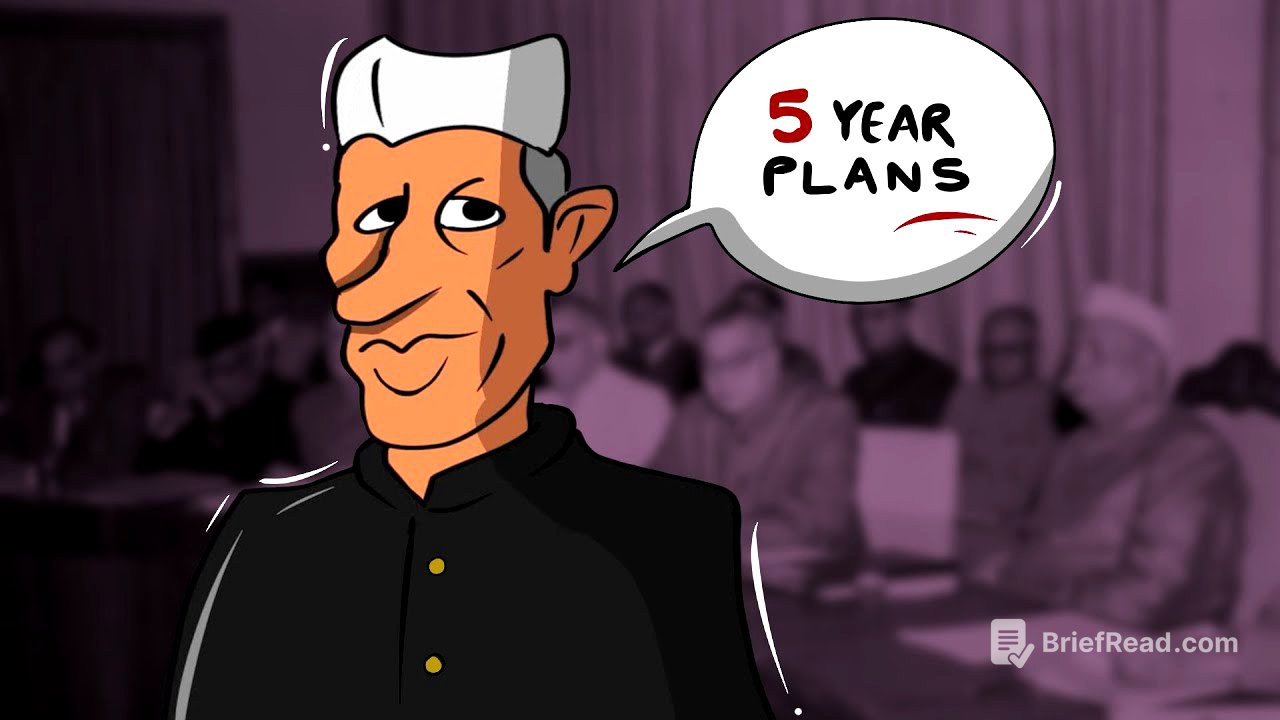TLDR;
This video provides an overview of India's economic development from 1950 to 1990, focusing on the economic systems adopted, the goals and implementation of the five-year plans, and the policies related to agriculture, industry, and trade. It highlights the shift towards a mixed economy, the importance of economic planning, and the impact of policies like land reform, the Green Revolution, and import substitution.
- India adopted a mixed economic system leaning towards socialism, balancing government planning with private sector encouragement.
- The five-year plans aimed for growth, modernization, self-reliance, and equity, with varying degrees of success across different sectors.
- Policies like land reform and the Green Revolution had significant impacts on the agricultural sector, while industrial policies focused on government control and protection of domestic industries.
Intro [0:00]
The chapter introduces the topic of India's economic development between 1950 and 1990, following up on the previous discussion about the state of the Indian economy at the time of independence in 1947. It sets the stage for examining the challenges India faced and the economic policies it adopted to address them.
Types of Economic System [0:24]
This section explains the three main types of economic systems: capitalist, socialist, and mixed economies. In a capitalist society, production is driven by demand and profit, with distribution based on purchasing power. Socialist societies feature government control over production and distribution based on needs. Mixed economies combine elements of both, with government and market forces jointly determining production and distribution. Examples of countries leaning towards each system are provided for clarity.
Economic System adopted by India [2:12]
India chose a mixed economic system after independence due to its diversity and inequality, which made extreme capitalist or socialist systems impractical. This system involved significant economic planning by the government while also encouraging the private sector. This approach aimed to balance economic growth with social equity.
Economic Planning in India [2:34]
Economic planning in India involved creating plans for the utilization of the country's resources to achieve specific goals within a five-year period. In 1950, the Planning Commission was established, with the Prime Minister as its chairman, to oversee the five-year plans. This commission was later replaced by NITI Aayog in 2015.
Goals of 5 Year Plans [3:00]
The five-year plans had four primary goals: growth, modernization, self-reliance, and equity. Growth referred to increasing the country's capacity to produce goods and services, measured by GDP. Modernization involved adopting new technologies and promoting social changes like gender equality. Self-reliance aimed to reduce dependence on imports, particularly in essential sectors like food. Equity focused on ensuring that the benefits of development reached all segments of society, including the poor.
Implementation of 5 Year Plans [4:58]
This section transitions into discussing how the goals of the five-year plans were implemented across different sectors of the Indian economy, specifically agriculture, industry, and trade, between 1950 and 1990. It sets the stage for a detailed examination of the policies and outcomes in each of these sectors.
5 Year Plans in Agricultural Sector [5:07]
In the agricultural sector, key initiatives included land reforms and the Green Revolution. Land reforms aimed to redistribute land from landlords to farmers, promoting equity and incentivizing productivity. The Green Revolution introduced high-yielding variety (HYV) seeds, increasing food grain production, especially for wheat and rice. However, HYV seeds required fertilizers, pesticides, and consistent water supply, benefiting farmers with better resources.
Debate over Agricultural Subsidies [8:40]
The chapter discusses the debate around agricultural subsidies, with some economists arguing that they are necessary to encourage the adoption of new technologies by small farmers, while others believe they distort the market and disproportionately benefit fertilizer industries. The counterargument suggests that removing subsidies would harm poor farmers, and the focus should be on ensuring subsidies reach the intended beneficiaries. Despite progress, a significant portion of the population remained employed in agriculture, indicating a need for diversification.
5 Year Plans in Industrial Sector [10:29]
The industrial sector was considered crucial for national progress, offering stable employment and promoting modernization. The Industrial Policy Resolution of 1956 divided industries into three categories: those exclusively owned by the government, those where the private sector could support government efforts, and those remaining under private control. The government also used a licensing system to regulate industries, promoting regional equality by offering incentives for setting up industries in economically backward regions.
5 Year Plans in Trade Policy [13:08]
India's trade policy during the first seven five-year plans focused on import substitution, promoting domestic production by restricting imports. This was achieved through tariffs and quotas, protecting domestic industries from foreign competition. The goal was to allow Indian industries to grow and become competitive over time, although export promotion received less attention until the mid-1980s.
Pros and Cons of Trade Policy [14:04]
The Indian industrial sector experienced impressive growth, with increased contributions to GDP and diversification beyond traditional textiles. Small-scale industries were promoted, enabling individuals with limited capital to start businesses. However, some economists criticized the dominant role of the public sector and the lack of competition, which hindered quality improvements. The license system and import restrictions also led to inefficiencies and a lack of incentive for Indian producers to enhance product quality.
Conclusion [15:14]
The chapter concludes by noting the conflicts and demands for policy changes that arose due to the inefficiencies and limitations of the existing economic policies. This ultimately led to the introduction of a new economic policy in 1991, based on liberalization, privatization, and globalization (LPG), which would be discussed in the next chapter.









